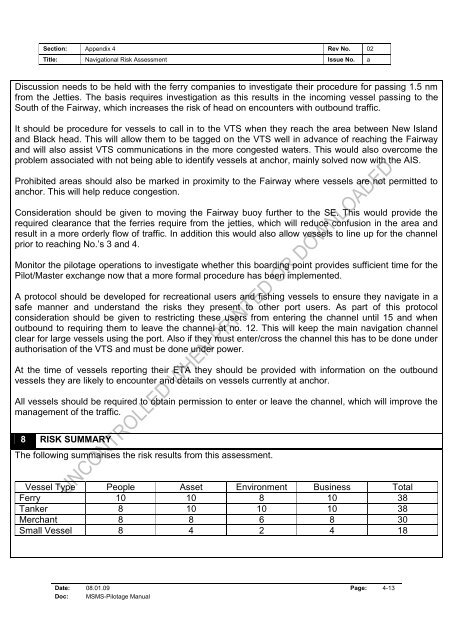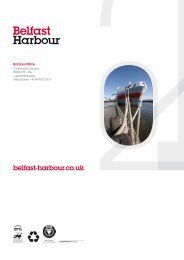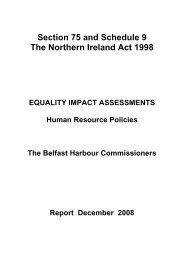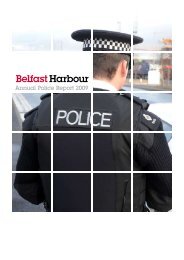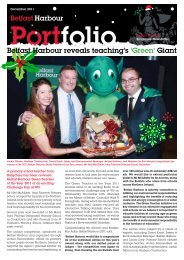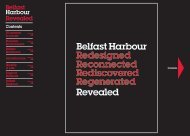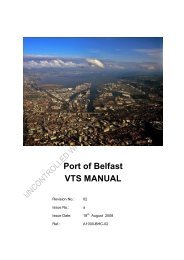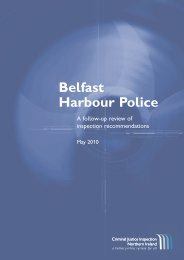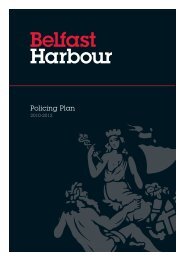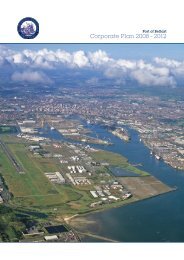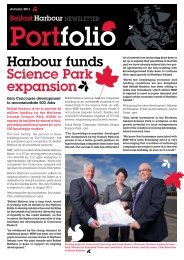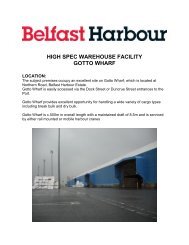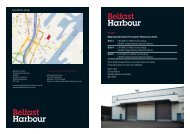Pilotage Manual - Belfast Harbour
Pilotage Manual - Belfast Harbour
Pilotage Manual - Belfast Harbour
Create successful ePaper yourself
Turn your PDF publications into a flip-book with our unique Google optimized e-Paper software.
Section: Appendix 4 Rev No. 02<br />
Title: Navigational Risk Assessment Issue No. a<br />
Discussion needs to be held with the ferry companies to investigate their procedure for passing 1.5 nm<br />
from the Jetties. The basis requires investigation as this results in the incoming vessel passing to the<br />
South of the Fairway, which increases the risk of head on encounters with outbound traffic.<br />
It should be procedure for vessels to call in to the VTS when they reach the area between New Island<br />
and Black head. This will allow them to be tagged on the VTS well in advance of reaching the Fairway<br />
and will also assist VTS communications in the more congested waters. This would also overcome the<br />
problem associated with not being able to identify vessels at anchor, mainly solved now with the AIS.<br />
Prohibited areas should also be marked in proximity to the Fairway where vessels are not permitted to<br />
anchor. This will help reduce congestion.<br />
Consideration should be given to moving the Fairway buoy further to the SE. This would provide the<br />
required clearance that the ferries require from the jetties, which will reduce confusion in the area and<br />
result in a more orderly flow of traffic. In addition this would also allow vessels to line up for the channel<br />
prior to reaching No.’s 3 and 4.<br />
Monitor the pilotage operations to investigate whether this boarding point provides sufficient time for the<br />
Pilot/Master exchange now that a more formal procedure has been implemented.<br />
A protocol should be developed for recreational users and fishing vessels to ensure they navigate in a<br />
safe manner and understand the risks they present to other port users. As part of this protocol<br />
consideration should be given to restricting these users from entering the channel until 15 and when<br />
outbound to requiring them to leave the channel at no. 12. This will keep the main navigation channel<br />
clear for large vessels using the port. Also if they must enter/cross the channel this has to be done under<br />
authorisation of the VTS and must be done under power.<br />
At the time of vessels reporting their ETA they should be provided with information on the outbound<br />
vessels they are likely to encounter and details on vessels currently at anchor.<br />
All vessels should be required to obtain permission to enter or leave the channel, which will improve the<br />
management of the traffic.<br />
8 RISK SUMMARY<br />
The following summarises the risk results from this assessment.<br />
Vessel Type People Asset Environment Business Total<br />
Ferry 10 10 8 10 38<br />
Tanker 8 10 10 10 38<br />
Merchant 8 8 6 8 30<br />
Small Vessel 8 4 2 4 18<br />
Date: 08.01.09 Page: 4-13<br />
Doc: MSMS-<strong>Pilotage</strong> <strong>Manual</strong>


